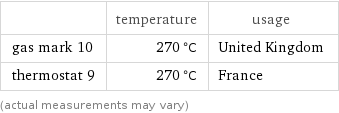Input interpretation

1-(4-chlorophenyl)-1-cyclobutanecarbonitrile | boiling point
Result

295 °C (degrees Celsius)
Unit conversions

568.2 K (kelvins)

563 °F (degrees Fahrenheit)

1023 °R (degrees Rankine)

236 °Ré (degrees Réaumur)

162.4 °Rø (degrees Rømer)
Comparisons as temperature

32.46 °C below melting point of lead (327.46 °C)

62.22 °C above autoignition temperature of book paper in Ray Bradbury's famous novel (451 °F)

(50 to 80) °C above autoignition temperature of paper (218 to 246 °C)
Corresponding quantities

Thermodynamic energy E from E = kT: | 49 meV (millielectronvolts)

Blackbody energy flux Φ from Φ = σT^4: | 5908 W/m^2 (watts per square meter)

Approximate luminous exitance from a planar blackbody radiator perpendicular to its surface: | 2.7×10^-7 lx (lux)
Nearest corresponding gas marks

| temperature | usage gas mark 10 | 270 °C | United Kingdom thermostat 9 | 270 °C | France (actual measurements may vary)